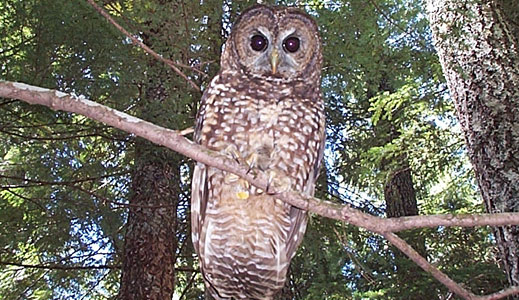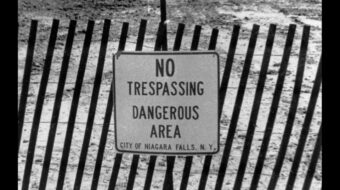
I stared at the drawer of owl specimens. It was 1988. I was measuring the talons of spotted owls and barred owls at Yale University’s Peabody Museum. Barred owls were reported to be making their way from Canada in the Pacific Northwest to spotted owl old-growth forest habitat in Washington state. I looked down at the Barred Owl in my hand but saw something else – a classic struggle of the fittest. And paying homage to Charles Darwin, I knew the outcome.
It was years later before I saw the majesty of old-growth forests out West. I took my young family to Glacier National Park in Montana. There I became mesmerized by the pillow and cradle topography of old-growth forests. I stared at it every day while drinking my morning coffee. The light flecks danced about as the Earth turned. Sounds from forest denizens emanated from deep within the darker shadows.
Besides being smitten with a new love, I also understood the rationale of the environmental community. While the spotted owl was the symbol and appeal, saving old growth was the objective. There was no hidden agenda. The spotted owl was adapted to old growth. This dark-eyed nocturnal predator would be a goner without it.
The measurements told a story yet to unfold. Actually, the numbers were superfluous. My unaided eyes showed me the significant advantage of the larger barred owl. Peter and Rosemary Grant, working with the famous Darwin Finches of the Galápagos Islands, taught us what even tiny differences meant.
In their study, the birds with a 0.5 mm greater beak depth had a significant advantage eating seeds, particularly during stressful drought periods. They tended to be healthier and procreate. The barred owl and its congener, the northern spotted owl, were contesting for wood rats, flying squirrels and other prey in the old growth – selective advantage to the barred.
In the Pacific Northwest, timber companies chopped up old growth. They created forest islands that played right into the talons of the barred owl. The latter handled a variety of habitats with aplomb. It was not so for its kissing cousin, the spotted owl. It was old growth or extinction.
So now certain so-called pragmatic elements are calling to make the barred owl the fall guy. Paul Henson of the U.S. Fish and Wildlife Service claimed by killing thousands – yes thousands – of barred owls, the spotted owl will have a chance of recovery. The bird-kill program by the U.S. Fish And Wildlife Service would cost $1 million annually. Sorry.
After the bloodletting, this kind of artificial selection will be bested by natural selection with ease. Transcendentalist Henry David Thoreau read Darwin. He said pay attention to this man. The Fish and Wildlife Service service has apparently decided differently.
Think of the precedent this would set. Changes in old forests in New England have made them more suitable for great horned owls. The latter prey on barred owls. Beyond owls, 111 bird species have recently expanded their ranges into at least one state. That is a whooping 19.5 percent of our bird species. Much of this has to do with humans changing wildlife habitat. Surely this expansion will kick off competition with birds in those states. Will government agencies now propose more killing of birds?
Old-growth forests are magical places. They look, sound and feel different. In some ways they are like it was before our species trod the good Earth. At one time, a squirrel could traverse along an old-growth forest canopy stretching from the Atlantic Coast to the Mississippi River. What little old growth remains, and that is mostly out West, we need to caress, not only for their predators but also for all the other beings that live there. In doing so, we retain part of our species history. After all, while on a different continent, we too started in the trees.
There is potential good news. Data from Washington state suggests a spatial separating out of the two owls. Barred owls appear to prefer forested valleys while the spotted owls have opted for forested slopes. I witnessed some of this staking out different turf between barred owls and great horned owls in the East. Competition and predation naturally exists among these denizens on the night shift. They may be finding their own way to coexist. The key is to preserve the old-growth forests.
Is there another agenda with the Fish and Wildlife Service’s precedent-setting approach? According to the proposed owl-kill plan, timber companies will be allowed into these old-growth forests to “thin” among these giants. The ecology of old growth depends upon trees and other vegetation eventually falling to the forest floor and decomposing. I read “thinning” as a green light to raid these last remnants of old growth.
Farley Mowat, of “Never Cry Wolf” fame, taught us that there are compromises and compromises. Some never should be made. Should we sacrifice wolves so hunters can ravish caribou herds? Mowat showed this was scientifically unsound as well as morally repugnant.
Should we sacrifice barred owls under the cover of saving spotted owls so timber companies can “thin” old-growth forests? Barred owls are now part of fragmented and old-growth forests. We have to accept it and learn the lessons. The best way to preserve spotted owls is to preserve old-growth forests. The Fish and Wildlife Service plan is neither good science nor a good compromise.
The National Forest Service and the Fish and Wildlife Service are failing to save old growth. So now they would perpetrate owl Armageddon purportedly to save owls. How cynical. They want us to be still, to still our souls with them. Don’t be still.
Len Yannielli is professor emeritus, Naugatuck Valley Community College, Waterbury, Conn. He was the 2009 National Association Of Biology Teachers Evolution Educator of the Year. This article originally appeared in the Seattle Times and is reposted by permission of the author.
Photo: Adult spotted owl. U.S. Fish & Wildlife Service – Pacific Region

MOST POPULAR TODAY

Zionist organizations leading campaign to stop ceasefire resolutions in D.C. area

High Court essentially bans demonstrations, freedom of assembly in Deep South


Afghanistan’s socialist years: The promising future killed off by U.S. imperialism

Communist Karol Cariola elected president of Chile’s legislature






Comments